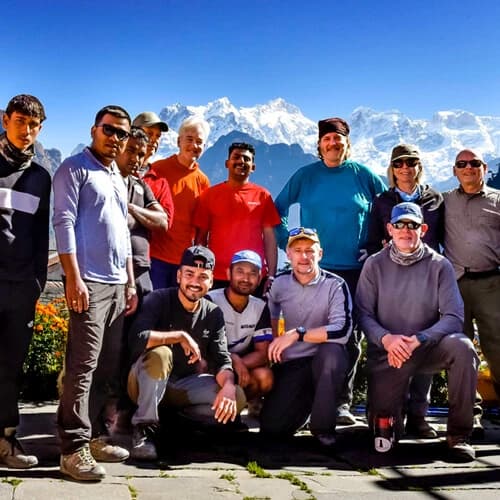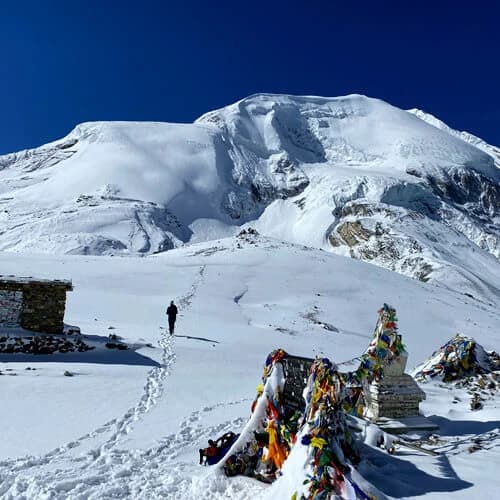Food on the Annapurna Circuit Trek
Numerous locally owned lodges and tea houses dot the Annapurna Circuit Trek trail, offering trekkers lodging facilities and food. A typical teahouse or a lodge in the Annapurna region has a large selection of food items, yet you might not find everything you're seeking. It is because the trail is still unreachable by road and the food you get on the most remote parts of the trail has to be carried to the lodge with the help of horses or porters.
number of hikers visiting the Annapurna Base Camp and the 12 Days Annapurna Circuit is high in the peak seasons, so the tea houses are also stocked up for the season, increasing your chances of getting more varieties on the menus. But if you’re trekking in an off-season, you need to be fine with the limited food items available. A significant factor in food availability is altitude as well. While teahouse menus at lower altitudes offer a wider variety of foods, those at higher altitudes typically include fewer options because of a shortage of supplies.
Both vegetarian and non-vegetarian food options are available in the Annapurna tea shops. Eating meat at higher elevations may strain your metabolism and cause digestive problems, hence it is not advised that you take non-vegetarian food while hiking. It is also advisable to steer clear of frozen food as it takes a long time to get to the tea shops and is therefore unsanitary. Sickness in between hikes is probably the worst thing to happen. Thus, try to limit your non-vegetarian eating habits and focus on vegetarian foods that are prepared locally.
When walking in the Annapurna region, you usually have three meals a day: breakfast, lunch, and dinner. Having some snacks on hand is always a smart idea for quick energy boosts. But, don’t overload your bags with tons of snacks.
Breakfast in Annapurna Circuit
Breakfast is the most important meal for your hiking days as it helps you kickstart your mornings on the trail. So, never miss your breakfast! It is typically served in the lodge or teahouse where you spend the night. You start the hike early to escape the midday sun, thus breakfast is also provided early in the day, from 6 to 8 am. There is nothing quite like enjoying a hot, substantial breakfast while observing the mountains bathed in the golden light of the rising sun.
Breakfast prices range from $3 to $8, based on altitude and portion size.
The type of breakfast you can have varies according to altitude. Here are a few of them:
Breakfast Set: Toast, chapati, or Tibetan bread with hash brown potatoes, a boiled or omelet egg, and a hot beverage (tea or coffee) make up the breakfast set which is filling and provides that boost of energy to begin the day hike.
Tibetan Bread: The most popular breakfast option for hikers in the Himalayas is the traditional Tibetan bread. It is a deep-fried flatbread that comes with honey, jam, or peanut butter on top. It can also have eggs and cheese added to it.
Pancakes: Several kinds of pancakes, including plain, chocolate, and banana varieties, are served with honey or peanut butter on top, particularly in the lower elevations of the trail.
Cereals: You can try some muesli, cornflakes, or porridge with milk or yogurt and fruit for a lighter breakfast option. It’s a healthier change if you’re tired of eating Tibetan bread and pancakes every day.
Paratha: Typically served for breakfast, paratha is an Indian flatbread stuffed with either potato, egg, or other veggies.
You can also have eggs alone, veggie soup, or French toast if you like something straightforward.
Lunch and Dinner
For lunch, we take a break in the middle of the hike at a tea house on the way. Depending on how long the journey will take and whether there are tea shops on that specific stretch of the path, you can eat lunch between 11 a.m. and 1 p.m. Typically, lunch breaks last one hour or two, during which you can take a little break while the food is being cooked. Lunch breaks are great for stretching your body and admiring the scenery that you get to see from your lunch spot.
Dinner is served in the teahouse or lodge where we spend the night. Once the day hike is concluded, you check in to your rooms in the tea house or a lodge, rest for a while, and join in for dinner in the dining hall. The Annapurna region tea houses serve dinner from 7 to 9 p.m. on most nights. The dining hall, where you eat your dinner is heated by a firewood heater in the center as it is chilly outside in the evenings.
You can purchase lunch or dinner for $4 to $10, depending on availability and altitude.
Here’s a list of lunch and dinner options that may be found at the Annapurna Circuit Trek lodges:
Dal Bhat: In Nepal's Himalayan trekking paths, Dal Bhat is the most popular dish to eat for lunch and dinner. Pickles, salad, and seasonal vegetables are served alongside white rice, known as Bhat, and lentil or pulse soup, Daal. It comes with a side dish of curry made with chicken or mutton for the non-vegetarian choice and vegetable curry for the vegetarian option.
Thukpa or Thentuk: It is a vegetable or non-vegetarian noodle soup that can be eaten for lunch or dinner. The thin long noodle is called Thukpa, and the flat square-shaped noodle is known as Thentuk. It's a perfect dinner for chilly weather because it's served hot and warm.
Chowmein or Noodles: Along the path, tea houses serve a unique variety of Nepalese noodles called chowmein. You can also savor a variety of light, easy-to-prepare, and quickly-made instant noodles.
Momo: Essentially a steamed dumpling, momo is another well-known Nepalese food that comes in vegetarian and non-vegetarian varieties. It is readily available in Nepalese cities and is also served on the Himalayan trails.
Rice and Curry: If the full-course Dal Bhat dish doesn't appeal to you, you can also have rice with a simple meat or veggie curry.
Fried Rice: White rice cooked with a variety of veggies, eggs, or meat is another well-liked meal in Nepal called Fried Rice that you can have for either lunch or dinner on the Annapurna trail.
Pizza: In restaurants at lower elevations, you may have pizza of all varieties for lunch or dinner. They might not be the best quality, though.
Pasta or Spaghetti: In the lower reaches of the walk, you can also have pasta and spaghetti seasoned with tomato sauce, veggies, meat, or eggs.
On the Annapurna region trekking trails, these are the most popular foods to be found. More options are available at lower altitudes, but you might not have access to all of them at higher altitudes. Moreover, the time of year you hike in affects the food items' availability. With fewer visitors, there aren't as many options available during the off-season. But there will be enough lodges open to accommodate and feed the few travelers that travel the Annapurna region even in the off-season.
Snacks
The day hike often ends around 3 or 4 in the evening. Since there will still be a few hours until dinner, you can have a little snack after the day trek. You can ask the teahouse workers to prepare you a quick dish, like instant noodles, or you can eat whatever you packed. Snacks are expensive at high altitudes. So, you can carry some lightweight snacks like cup noodles, chocolate or protein bars, cookies, etc.
Drinks on the Annapurna Circuit Trek
Maintaining adequate hydration is crucial for a successful trip, especially in the high-altitude Annapurna region. Fluid intake tremendously helps in minimizing the risks of altitude sickness. As a result, to help you maintain a healthy water level, the trail provides a variety of drinks that are both made locally and transported from adjacent towns. Let's learn more about the beverages that are offered in the tea shops along the 15 Days Annapurna Circuit Trek route.
Drinking Water
Water is the most important beverage to have while trekking. One should consume 4 liters or more water daily in order to stay hydrated as there’s more water loss in the form of sweat while hiking. Staying hydrated with water helps you fight altitude sickness and adjust better to the increasing altitude every day.
You won't find any drinking water supply on the trails because of their remote location. Locals rely on natural water sources like rivers and springs, which are unsafe for tourists to drink directly. Thus, the tea shops heat up water and offer it to their customers. While the tea house where you stay provides free boiled water, you will need to pay a small fee of $1 or $2 at the tea shops located along the route for a liter of boiling water. You can further clean boiling water by adding a purifying liquid or tablets if you're still not sure if it's safe. Carrying a water bottle with a built-in filtration system and filtering the water from natural sources along the trail is the best solution.
You can also purchase bottled water for $1 to $2, although we strongly discourage using single-use plastic bottles on the path due to the growing amount of plastic debris in the Annapurna trails.
Hot Drinks
On the Annapurna hike, hot beverages like tea and coffee are widely available. Hikers in the Himalayas have enjoyed the company of tea and coffee for years. After a long day, sipping tea and coffee becomes a calming habit, warming the chilly mountain air. Your body gets the caffeine it needs to stay energized for the duration of the hike from moderate amounts of tea and coffee. You can choose from Tibetan tea, milk tea, black tea, mint tea, ginger tea, lemon tea, or green tea. You can also have milk or black coffee. Hikers also enjoy drinking hot lemon with ginger honey and garlic soup, which are excellent remedies for altitude sickness.
Depending on what you're drinking and the altitude you're at, a hot beverage might cost anywhere from $2 to $5.
Soft Drinks
Soft beverages such as Coca-Cola, Fanta, Sprite, Pepsi, canned juice, energy drinks, etc. are readily accessible in the Annapurna trails. To relieve your thirst, you can enjoy a reasonable amount of these cold beverages. But soft drinks have caffeine, and too much of it might cause you to get dehydrated, which exacerbates altitude sickness. So, drink soft drinks in moderation. The cost of these drinks may be higher than the MRP and the price goes even higher with increasing altitude.
Alcoholic Beverages
The Annapurna region has a large selection of locally made alcoholic beverages with distinctive flavors and cultural significance. There's plenty of locally produced raksi as well as some globally recognized beer, whiskey, rum, and vodka. Although it's tempting to savor these treats frequently, you should resist the urge, especially when you're at a high altitude. Your body becomes dehydrated when you drink alcohol, and this increases your risk of altitude sickness. So, be mindful while indulging in alcoholic drinks and avoid it completely while hiking up.
Accommodation on the Annapurna Circuit Trek
Many years ago, when trekking was new to the Himalayas, the Annapurna region used to be a popular destination for camping treks. However, things are completely different now. You don’t have to sleep in tents anymore unless you want to. Along the trail, there are several cozy lodging alternatives, including lodges, tea houses, and homestays that are designed to meet the demands of hikers. You won't have any trouble finding accommodation while you're trekking to the Annapurna Base Camp or the 10 Days Annapurna Circuit. However, you have to book your accommodation in advance for the peak season. Sometimes, during the high trekking season, trekkers have to spend the night in the dining hall due to a lack of rooms available.
The hiking season and the elevation attained on the route affect how much lodging costs. During the busiest season, staying at lower altitudes costs $3 to $5 USD. However, lodging gets more expensive the higher you go, reaching about $7 to $10 USD. Lower elevation accommodations are $2 to $3 USD during the off-season. But, the price goes up to about $5 to $7 USD as you go higher.
Tea Houses
A teahouse is the most popular and traditional kind of accommodation on the trail. They are usually located in a smaller village along the hiking routes. A local owns a tea house, which is essentially a house with minimal rooms set aside for hikers to stay the night. These tea houses are available in a range of designs, from low-cost versions with basic amenities to more opulent versions with features like Wi-Fi and hot showers.
A room with twin beds, a shared restroom (usually with squat toilets), and communal dining rooms are standard amenities offered by teahouses. The atmosphere in the teahouse is friendly, and the owners are warm and inviting. In the tea houses, you can chat with other hikers, exchange stories, and learn about the state of the trail.
Lodges or Guesthouses
Although they are usually more expensive, lodges are cozier and larger than teahouses. Guest houses often serve Western food and offer private bathrooms and hot showers. They are typically located in larger towns or villages and may include extra amenities like free internet access. Certain lodges have room heating, which is a pleasant comfort on chilly evenings. The majority of these guest houses are situated in prime locations so you can take in the picturesque views of the mountains.
Homestays
Several villages in the Annapurna region like Ghandruk and Ghorepani have homestays in addition to lodges and tea houses. Homestays provide you the chance to fully experience traditional Nepali cultures. You’ll be staying at the villagers’ home with their family. Along with learning about the local way of life, you will also discover how the climate and geography impact day-to-day existence in the Himalayan villages.
Camping
A few daredevils who prefer a more conventional camping experience can even camp their way through the Annapurna journey. It may be more difficult to camp than to stay at a tea house as you have to carry all of your essentials along the way. So porters will be needed to help you carry the camping gear.
What to expect in an Annapurna lodge or a tea house?
The 8 Days Annapurna Circuit Trek lodges and tea houses are constructed with solid stone walls and feature compact rooms with simple furnishings. For most of the hike, you will be utilizing common restrooms with Asian squat toilets. Apart from their decent rooms, tea houses, and lodges also feature a shared dining area with a fireplace and a kitchen where food is cooked.
Rooms
The rooms come with two single beds, mattresses, warm blankets, bedsheets, pillows, and pillowcases and are available for twin sharing. You may have to share your room with another trekker during peak season due to the lack of available rooms. You can bring a pillow cover for cleanliness and your own sleeping bag for added warmth. Since it is impossible to hand wash and sun dry the sheets every day in the frigid temperatures of high elevations, they are not changed after every usage. So, sleeping bags let you maintain an extra layer of hygiene as well.
Dining/Communal Area
There is usually a common eating area in lodges and tea houses where hikers gather to share stories about their days. A fireplace in the center of the dining area is used to heat the space and boil water. After a long, exhausting day, getting together around the fireplace to share and laugh is a fun experience to end the day. Additionally, the communal room has benches or tables where people can sit and eat.
Restrooms
At lower elevations on the trek you may have access to private restrooms with running water and western toilets; but, at higher elevations, you will have to use shared restrooms with Asian-style squat toilets. Even though there might not always be flowing water, you will always have access to containerized water. Because toilet paper and other necessities sometimes run out, it's advisable to bring your own for hygienic reasons. Although you may obtain hot showers for $2 or $3, it's not a good idea to take regular baths in this bitterly cold weather.
Internet Access
We can't fully rely on the free WiFi that some lodges, particularly those at the lower elevations, offer to the hikers. Generally, there is limited and patchy WiFi coverage. Therefore, wherever there is network coverage, it is preferable to use mobile data. Before heading out on the hike, you can purchase an NTC or Ncell SIM card in Kathmandu and use its mobile data on the go.
Power Supply
Where there’s no hydropower supply, solar energy is used to light the dining area, kitchen, and rooms. The common area will feature a charging station where you can charge your phones, camera batteries, power banks, torches, and other equipment, even though the rooms don't have charging plugs. Because the charging station must fit all of the trekkers' gadgets staying at that specific teahouse, use caution when using it and let others use the facility as well.
In conclusion, the Classic Annapurna Circuit Trip offer sufficient food and comfortable accommodations. However, don't expect to stay in opulent lodgings like those found in the cities like Kathmandu and Pokhara. The assortment of food options and lodging sites on the way to the Anapurna Base Camp or the Annapurna Circuit make it easy to complete the hike. During the night, make sure you have enough clothes and blankets to keep you warm. Eat well, stay hydrated, and prevent illness. This is the only way for a successful Annapurna Circuit Trek.
Please contact us via email at info@outfitternepal.com or by Whatsapp at +977 9851137385 if you would like further information on trekking in the Annapurna region. We'll make every effort to help you. Enjoy your trekking!
Some Most Popular Treks




